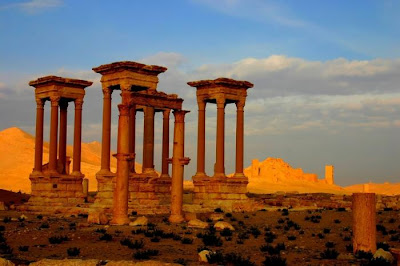PALMYRA is in the headlines this week as the sad target of DAESH Islamic militants, who have vowed to destroy all "heathen" art and architecture as they did recently at Nimrud, Hatra and Nineveh.
Antinous and Hadrian visited the fabled "city of the desert" Palmyra during their three-year tour of the Eastern Empire.
But when they were there 1,900 years ago ingenious "terra-farming" kept the desert at bay, according to new findings.
For centuries, experts have been somewhat bewildered as to how this city could have achieved wealth and prosperity in the middle of a desert.
In the 3rd Century AD, Palmyra was so prosperous, that its queen Zenobia launched a revolt against Rome. She conquered Egypt before being defeated and taken as a hostage to Rome by Emperor Aurelian.
According to a new study, Palmyra was a miracle of human ingenuity and "terra-farming" which could serve as a model for water-thirsty urban areas today such as Phoenix, Arizona.
Palmyra was surrounded by a number of villages that fed the city and together they harnessed rain water resources necessary for survival.
"The archaeologists gathered evidence that residents of ancient Palmyra and the nearby villages collected the rainwater using dams and cisterns. This gave the surrounding villages water for crops and enabled them to provide the city with food. The collection system ensured a stable supply of agricultural products and averted catastrophe during droughts," according to findings by Norwegian researchers.
Archaeologists from the University of Bergen in Norway and the Palmyra Museum mapped a large expanse of land around the city of Palmyra with the help of satellite photos and to their surprise, a large number of remains of villages from ancient Roman times were detected to the north of the ruined city. Remains of 2,000-year-old water reservoirs were also found.
"We were able to form a more complete picture of what occurred within the larger area," project manager Jørgen Christian Meyer, a professor at the University of Bergen, said, adding, "These findings provide a wealth of new insight into Palmyra’s history."
Once a flourishing city, with a population of 100,000 inhabitants, and a part of the Roman Empire, Palmyra was an oasis for travellers in the Syrian Desert, northeast of modern-day Damascus.
The city was first mentioned in the archives of Mari in the second millennium BC, The Roman Empire took over Palmyra in the middle of the 1st Century AD as part of the Roman province of Syria, according to UNESCO, which declared the Palmyra ruins to be on the World Heritage List in 1980.
"It grew steadily in importance as a city on the trade route linking Persia, India and China with the Roman Empire, marking the crossroads of several civilisations in the ancient world," UNESCO says about Palmyra on its official Website.
Despite its location in a semi-arid region, Palmyra became a thriving and prosperous city about 2,000 years ago by cultivating the desert soil and using rain water, something human beings of today could learn from and do even better, with all the available modern aids and methods, to feed many and bring about sustainable development.
Palmyra is still at a crossroads of history, and fighting between Syrian government forces and insurgents reportedly has damaged ruins at the ancient site.
Antinous and Hadrian visited Palmyra on their fateful tour of the Eastern Empire.
FLAMEN ANTONIUS SUBIA writes:
"The inner circle of Hadrian's court, with a light escort, visited Palmyra in what is now Eastern Syria, near the northern Iraqi border. Palymra was an ancient buffer state between the Roman and the Persia Empires, which had now been at peace for many years.
"Palmyra was therefore a mixture of both cultures, with its own, ancient Assyrian and Hittite blood beneath the surface.
"According to Marguerite Yourcenar, Antinous was initiated into the Cult of Mithras while at Palmyra to the displeasure of Hadrian who was already an initiate, and perhaps an influential leader of the secret cult because of his position as Pontifex Maximus.
"Coming after the Zoroastrian sanctification in Armenia, and given the Phrygian aspect of the Mithraic cult, and the proximity to the Persian border, and the end of the transition from the Age of Taurus to the Age of Aries, which the cult revealed, we celebrate the initiation of Antinous into the mysteries of Mithras and their cosmic revelation."




No comments:
Post a Comment